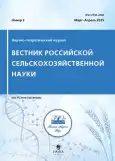Influence of weather conditions and technological methods on the spring wheat crop structural basis formation
- 作者: Mitrofanov Y.I.1, Smirnova Y.D.1, Antsiferova O.N.1, Pervushina N.K.1
-
隶属关系:
- Federal Research Center “V.V. Dokuchaev Soil Institute”
- 期: 编号 2 (2025)
- 页面: 69-75
- 栏目: Farming
- URL: https://journal-vniispk.ru/2500-2082/article/view/293974
- DOI: https://doi.org/10.31857/S2500208225020149
- EDN: https://elibrary.ru/HVLDSS
- ID: 293974
如何引用文章
详细
Studies were conducted in 2011–2023. In field experiments at the Gubino of the All-Russian Research Institute of Reclaimed Lands (Tver region). The purpose of the research is to establish the impact of weather conditions and individual technological techniques on the productivity and structure of the harvest of spring wheat in the conditions of a Non-Black Earth Zone. The main studies were conducted on a drained and waterproof (not drained) areas in experience with three technologies (extensive – without fertilizers, medium-intensity – normal and intense). In additional experiments, the effectiveness of the gaping of the soil, crested plowing and crested sowing of spring wheat was studied. The soil under the experiments is sod-podzolic, light-drying gleyed, cultivated. Studies have established that on temporarily overlapped lands the main directions of intensification of agriculture are their drainage and use of fertilizers. With the joint action of these factors, the yield of spring wheat increases by more than 2 times. The shared participation of mineral fertilizers in the total growth of the crop of spring wheat was 77.9–84.9%, drainage – 15.1–22.1%. The structural model of biological productivity of spring wheat with a crop level of more than 5.0 tons of grain per 1 ha is a sowing with a density of stem 500 or more ears per 1 m2 with a grain mass in a ear of more than 1.0 g. Under the influence of adverse weather conditions, the number of stems with the spike was reduced by 25.9%, the number of grains in the spike – 17.9%, the mass of 1000 grains – 30.4%. The use of fertilizers has a more significant impact on the increase in the number of grains in the spike, agromeliorative techniques for soil processing and sowing – on an increase in the density of productive stem. The inclusion of agromeliorative technologies and processing techniques aimed at improving the agrophysical state of the soil to the technological registers of the cultivation of spring wheat should be considered as an important element of their adaptation to the agroecological conditions of drained lands.
全文:
作者简介
Yuri Mitrofanov
Federal Research Center “V.V. Dokuchaev Soil Institute”
编辑信件的主要联系方式.
Email: vniimz@list.ru
PhD in Agricultural Sciences
俄罗斯联邦, MoscowYulia Smirnova
Federal Research Center “V.V. Dokuchaev Soil Institute”
Email: vniimz@list.ru
PhD in Biological Sciences
俄罗斯联邦, MoscowOlga Antsiferova
Federal Research Center “V.V. Dokuchaev Soil Institute”
Email: vniimz@list.ru
PhD in Agricultural Sciences
俄罗斯联邦, MoscowNatalia Pervushina
Federal Research Center “V.V. Dokuchaev Soil Institute”
Email: vniimz@list.ru
俄罗斯联邦, Moscow
参考
- Balun O.V. Ekologicheskie rezhimy meliorirovannyh zemel’ v Novgorodskoj oblasti // Agrarnaya nauka Evro-Severo-Vostoka. 2024. № 25(3). S. 435–443. https://doi.org/10.30766/2072-9081.2024.25.3.435-443
- Veklenko V.I., Soloshenko R.V., Dolgopolov A.V. Upravlenie razmerami i strukturoj posevov zernovyh kul’tur v Kurskoj oblasti // Vestnik Kurskoj gosudarstvennoj sel’skohozyajstvennoj akademii. 2022. № 7. S. 232–238. Rezhim dostupa: https://elibrary.ru/item.asp?id=49727226 EDN: MSFRLJ
- Demina E.A., Romenskaya S.E., Taranova T.Yu., Chekmasova K.Yu. Vliyanie listovyh podkormok zhidkimi kompleksnymi udobreniyami na urozhajnost’ i kachestvo zerna yarovoj myagkoj pshenicy // Zemledelie. 2024. № 7. S. 25–26. https://doi.org/10.24412/0044-3913-2024-7-25-29
- Drobot V.A., Brusencov A.S. Agromeliorativnye priemy pri poverhnostnoj obrabotke pochv // God nauki i tekhnologij 2021: sb. tezisov po mat-lam Vseros. nauchno-prakt. konf. Krasnodar: Kubanskij gosudarstvennyj agrarnyj universitet imeni I.T. Trubilina, 2021. S. 252. Rezhim dostupa: https://elibrary.ru/item.asp?id=46623388
- Zhuravleva E.V., Milashchenko N.Z., Sapozhnikov S.N., Trushkin S.V. Sistema uvelicheniya proizvodstva vysokokachestvennogo zerna pshenicy // Dostizheniya nauki i tekhniki APK. 2020. № 34(3). S. 7–10. https://doi.org/10.24411/0235-2451-2020-10301
- Kiryushin V.I. Koncepciya razvitiya zemledeliya v Nechernozem’e. SPb.: OOO «Kvadro», 2020. 276 s. Rezhim dostupa: https://elibrary.ru/rzgopo
- Kiryushin V.I. Upravlenie plodorodiem pochv i produktivnost’yu agrocenozov v adaptivno-landshaftnyh sistemah zemledeliya // Pochvovedenie. 2019. № 9. S. 1130–1139. https://doi.org/ 10.1134/S0032180X19070062
- Mal’chikov P.N., Myasnikova M.G. Vklady massy 1000 zeren i chisla zeren v prirost urozhajnosti v processe selekcii tverdoj pshenicy v Samarskom NIISH // Dostizheniya nauki i tekhniki APK. 2024. № 38(9). S. 10–16. https://doi.org/10.53859/02352451_2024_38_9_10
- Mitrofanov Yu.I., Anciferova O.N. Grebnistyj sposob poseva zernovyh kul’tur na osushaemyh zemlyah // Agrarnaya nauka Evro-Severo-Vostoka. 2020. № 3. S. 301–312. https://doi.org/10.30766/2072-9081.2020.21.3.301-312
- Mitrofanov Yu.I., Gulyaev M.V., Pugacheva L.V., Pervushina N.K. Novyj sposob shchelevaniya osushaemyh pochv // Mezhdunarodnyj sel’skohozyajstvennyj zhurnal. 2022. № 5. S. 541–545. https://doi.org/10.55186/25876740_2022_65_5_541
- Popov F.A., Kozlova L.M., Noskova E.N. Vliyanie resursosberegayushchih tekhnologij vozdelyvaniya zernovyh kul’tur na produktivnost’ polevogo sevooborota // Agrarnyj vestnik Verhnevolzh’ya. 2019. № 2(27). S. 12–15. https://doi.org/10.35523/2307-5872-2019-27-2-12-15
- Gyrka A.D., Gasanova I.I., Gyrka T.V., Bokun O.I. Growth, development and productivity of winter wheat depending on the different soil tillage and sowing systems // The Scientific Journal Grain Crops. 2018. Vol. 2(1). PР. 88–93. https://doi.org/10.31867/2523-4544-2018-2-1-88-93
- Jaswal A., Prasad D., Singh A., Singh M. Fertilizers and Their Role in Plant Growth. India, Delhi: Bright Sky. (Publ.). 2022. 77 p. https://doi.org/10.22271/bs.book.30.
- Lucena Marinho J., Ricardo Silva S., de Batista Fonseca I.C. Technological quality of wheat grains and flour as affected by nitrogen fertilization and weather condition // Emirates journal of food and agriculture. 2023. Vol. 34(12). PР. 997–1011. https://doi.org/10.9755/ejfa.2022.v34.i12.2977
- Natroshvili D., Lomishvili M. Determining the optimal sowing frequency and sowing norm of cereal crops // American Scientific Research Journal for Engineering, Technology, and Sciences. 2021. Vol. 78(1). PР. 73–82. URL: https://www.researchgate.net/publication/350655164_Determining_the_Optimal_Sowing_Frequency_and_Sowing_Norm_of_Cereal_Crops
补充文件












